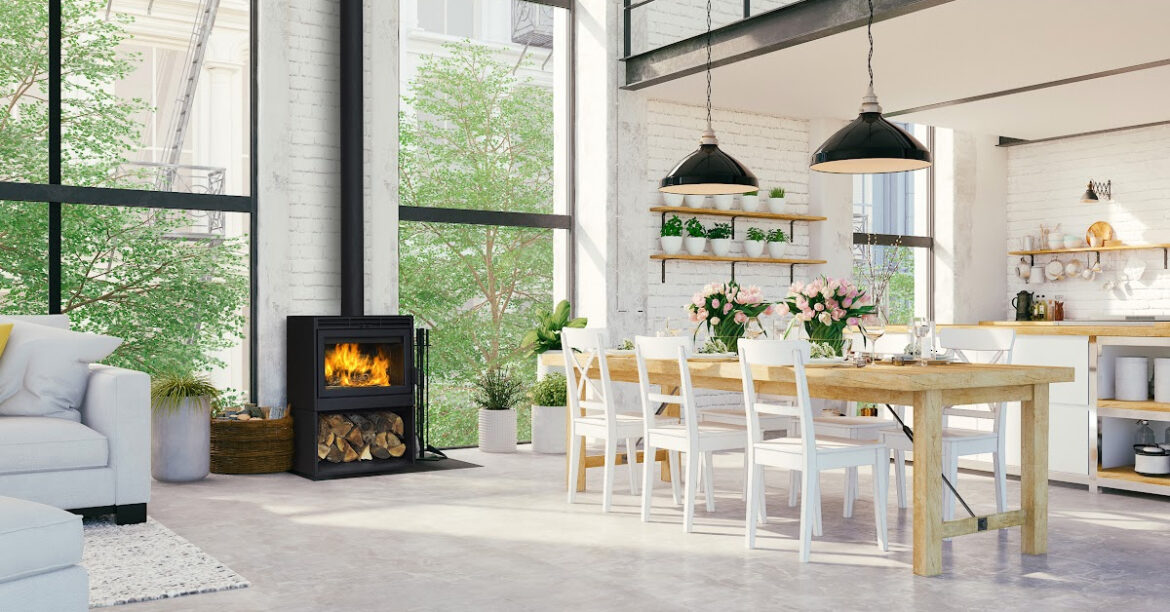START WITH A WIRE BRUSH AND STEEL WOOL
The first step is to move the stove to a work space or thoroughly protect the area around the stove with drop cloths. Things may get a wee bit dirty!
If possible, remove the door from the stove and the glass from the door frame. Plan to replace both the door gasket and the glass gasket.
Any peeling, blistering or chalking of rusty old paint must be removed. Do this by aggressively scrubbing the top and sides of the stove with a stiff bristled wire brush. Coarse steel wool or even sand paper may work well, too. Using a shop vac, clean up all the dust and flakes of rust. If you’re doing this project outside and you have access to an air compressor, blow off all the dust.
This is also the time to remove any old gasketing by thoroughly scraping the door and glass channels. Inspect and if necessary, remove and replace any loose refractory cement from the interior of the stove. Any crumbling or broken firebrick should be replaced.
RUST REMOVER
The next order of business is to remove all signs of rust. Using a rust remover from your WE LOVE FIRE® dealer or the hardware stove, spread it generously on the stove’s top and sides, and on the door. Most rust removers need a heavy application and need to soak for several minutes before scrubbing with steel wool. Follow the directions on the bottle.
Depending on the severity of the rust, some people formulate their own rust remover by mixing a smooth paste of baking soda and water. Naval jelly can be another option. Leave either mixture on the stove, liberally applied, for an hour before scrubbing with steel wool.
The key to this step is to be patient. Surface preparation is very important! Don’t rush it! Try to completely clean any signs of rust from the surface by wiping with dry cloths until no rust residue is seen. You may have to repeat this process.
In addition to all the rust, make sure that any other contaminants, like oil and grease, have been removed from the stove. Do not use mineral spirits or a paint thinner on the appliance. These leave a residue that will affect the adhesion of the paint.
Once you’re satisfied with the condition of the stove, let it thoroughly dry for several hours or better yet, overnight.
LET’S PAINT!
There are three key elements when you get to this point in the project:
1) Take your time, do not rush.
2) Three thinner coats of paint are much better than one heavier coat.
3) Make sure you use the correct type of paint. It needs to be a high temperature, stove paint.
The two primary manufacturers of high temp stove paint are Stove Bright and Thurmalox. Your WE LOVE FIRE® expert will have paint on the shelf. Buy one of these brands and simply follow the instructions on the can. Don’t try to cover everything with one coat; think three lighter, thinner coats instead of trying to cover everything with the first coat of paint.
If the stove is down to the bare, shiny metal and you want to use a primer coat, be sure it’s compatible with the high temperature aerosol stove paint. Both manufacturers make a high temp primer paint.
For most stoves, two cans of paint should be sufficient. If you’re repainting the top only, one will suffice. Incidentally, your black stove does not have to stay black any longer! There are over 30 colors of high temperature paint for wood-burning stoves!
DRYING AND CURING
High temperature stove paint dries quickly. Allow 15 – 30 minutes between thin coats. The paint will be dry enough to touch in about 2 hours. You’ll need to wait several hours, though before the “curing process” for your stove. This is probably a good time to replace the door gasket and the gasket material for the glass.
The paint will give off fumes and smoke during the first few initial burns. Again, follow the instructions on the can, but two or three small and quick fires will properly cure the new paint to the stove.
During these brief fires, there might be some visible smoke near the surface of the stove along with an unpleasant odor. This is normal. If you are indoors, keep the area well ventilated. Those with health issues or sensitivities should avoid the area until the curing process is completed. The fumes should not continue after three short burns.

OTHER THOUGHTS
A couple other quick points worth mentioning. A spray trigger, attached to the nozzle of the paint can is a good idea. It’s inexpensive and easy to use. It will help to insure a smooth application of the paint. Also, think about painting the connector pipe (or the vent pipe on your gas model) the same color to match the new color of the stove! It’s a nice, finishing touch for the room.
Products like refractory cement, silicone sealant, rope and tape gasket, high temperature paint, paint sample cards, replacement firebrick, glass cleaner, etc. are available at your nearby WE LOVE FIRE® dealer. If they don’t have it in stock, they’ll be glad to order it!
Keep in mind that the extra time and effort in surface preparation and applying three thin coats of paint will lead to the best results for a beautiful and long-lasting finish for your stove.

